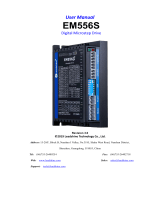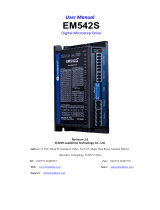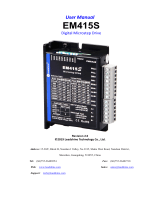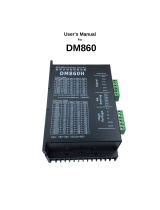Page is loading ...

Table of contents
D9-3_EN – V1.0 2/14
Table of Contents
1 Safety Instructions, Protective Measures and Guidelines............................ 3
1.1 Important Instructions ........................................................................ 3
1.2 Qualified Personnel ........................................................................... 3
1.3 Maintenance ...................................................................................... 3
1.4 Safety Instructions ............................................................................. 4
1.4.1 Classification of Information .............................................................. 4
1.5 Electromagnetic Compatibility ........................................................... 4
2 Product Overview ............................................................................................. 5
2.1 Technical Data .................................................................................. 5
2.1.1 Dimensions ....................................................................................... 5
2.1.2 Mechanical Data ............................................................................... 5
2.1.3 Electrical Data ................................................................................... 6
2.1.4 Environmental conditions .................................................................. 6
3 Installation ........................................................................................................ 7
3.1 Mechanical Installation ...................................................................... 7
3.2 Electrical Installation.......................................................................... 7
3.2.1 Pin Assignment ................................................................................. 8
3.2.2 Connection Scheme Signal In/Output ............................................... 8
3.3 Integration into Safety Circuits .......................................................... 9
4 Initial Operation ...............................................................................................10
4.1 Configuration ....................................................................................10
4.1.1 Motor Current ...................................................................................10
4.1.2 Standstill Current and Autotuning .....................................................11
4.1.3 Micro-Stepping .................................................................................11
4.1.4 Selection Constant Speed ................................................................12
4.1.5 Drive Mode .......................................................................................12
4.2 Motor Direction .................................................................................12
5 Execution of Movements ................................................................................13
5.1 Pulse Mode – Step/Direction ............................................................13
5.2 Loop Mode – Constant Limit to Limit Motion ....................................13
6 Status and Error Messages ............................................................................14
7 Accessories .....................................................................................................14
8 Service .............................................................................................................14

Safety Instructions, Protective Measures and Guidelines
D9-3_EN – V1.0 3/14
1 Safety Instructions, Protective Measures and Guidelines
1.1 Important Instructions
Read this manual carefully before operating the motor controller. Familiarise with the safety instructions and ensure that the
required safety measures are followed.
This manual was created according to the best of our knowledge and belief. It is used for technical documentation and for
assisting the user during the initial operation. The warnings, cautions and instructions issued by igus® regarding the motor
controller must in any case be passed on to the end user if the motor controller is used as part of an overall system.
igus® undertakes warranties only for igus® products in accordance with the standards, norms and specifications given in this
manual. The guarantee covers only the replacement or repair of a defective motor controller. There is no liability for
consequential damage and consequential errors. igus® does not take any responsibility for the integration of the motor controller
into the overall system. The responsibility for it lies with the plant designer or the end user. Please observe the instructions
under "Qualified Personnel". igus® assumes no liability for personal injury or damage to property resulting from misuse or
unauthorised technical modification of the motor controller.
igus® reserves the right to make changes and improvements to the product or the technical documentation at any time without
prior notice.
The motor controller must only be used if:
- All information and safety instructions in this manual have been observed.
- No changes have been made to the motor controller and it is in a technically flawless condition.
- The operating limits that are specified in technical data are complied with.
- Necessary measures, if called for, have been taken for radio interference suppression depending on the operating
environment.
- All connection cables used are strain relieved.
1.2 Qualified Personnel
The operation of the product must only be carried out by qualified personnel.
Personnel must:
- Have read and understood this manual and documentation on the installed motor, axis and accessories.
- Be familiar with all relevant applicable standards, provisions and accident prevention regulations.
- Be able, due to their training, to anticipate or recognise any hazards that may arise when using the control system.
- Ensure the safety of persons and objects when using the motor control system in the overall system.
1.3 Maintenance
The motor controller is maintenance-free.
Never open the housing of the motor controller independently, even in the event of a malfunction.
Opening the housing will void the warranty.

Safety Instructions, Protective Measures and Guidelines
D9-3_EN – V1.0 4/14
1.4 Safety Instructions
1.4.1 Classification of Information
The degree and type of hazard are assigned to one of the following classes.
DANGER!
Safety instructions marked with DANGER indicate an imminently hazardous situation.
A disregard of the notice inevitably leads to a serious or even fatal accident.
WARNING!
Safety instructions marked with WARNING indicate a potential hazardous situation.
Failure to observe this notice is likely to result in a serious or fatal accident or property damage.
CAUTION!
Safety instructions marked with CAUTION indicate potential danger.
Failure to comply with the notice may possibly result in an accident or property damage.
NOTE
Safety instructions marked with NOTE indicate a potential hazardous situation.
Disregard of the notice may possibly result in property damage.
1.5 Electromagnetic Compatibility
WARNING!
• Risk of injury due to interference with signals and devices
Disturbed signals can cause unforeseen device reactions. Carry out the wiring in accordance with the EMC measures.
Failure to follow these instructions can result in death, serious injury, or material damage
Measures for EMC
Effect
Device assembly
Use cable clamps for the shield support,
connect metal parts over a large area.
Good conductivity due to surface contact.
Switching devices such as contactors, relays
or solenoid valves with interference
suppression units or spark suppressors (e.g.
diodes, varistors, RC elements)
Reduce mutual interference couplings.
Wiring
Keep cables as short as possible.
Avoid capacitive and inductive interference.

Product Overview
D9-3_EN – V1.0 5/14
2 Product Overview
This motor controller can control stepper motors with up to 7 A continuous current at a supply voltage of up to 48 V.
Ready for immediate use
Connect the voltage source, control signals and motor and you're ready to go. No complicated software installation or time-
consuming wiring of various additional switches and sensors.
Simple control
With the loop mode, a continuous movement between 2 limit switches can be executed without the need for a master controller.
The movement is executed at a fixed pre-set speed.
Precise positioning
When using the Pulse Mode, simple clock signals can be used for highly precise positioning. In combination with a PLC or a
microcontroller, even highly complex applications can be realised.
2.1 Technical Data
2.1.1 Dimensions
2.1.2 Mechanical Data
D x W x H motor controller in mm
75,5 x 33 x 112
Weight
300 g

Product Overview
D9-3_EN – V1.0 6/14
2.1.3 Electrical Data
Power supply
24 V up to 48 V, ± 2 V
Motor type
Stepper motor
Standstill current
1,1 A up to 6,3 A
Continuous motor current
2,2 A up to 7 A
Peak motor current
3 A up to 9,8 A
Current Drain Logic
40 mA at 24 V
26 mA at 48 V
Voltage Step/Direction inputs
5 up to 24 V, -0,5 V + 2 V
Input frequency
2 Hz up to 1 MHz
Step input signal width
Min. 250 ns
Direction input signal width
Min 50 µs
Dissipation Loss
Max. 470 W
Digital Inputs/Outputs
Galvanically Separated by Optocoupler
Voltage supply output „Out“
Max. 30 V
Current output „Out“
Max. 100 mA
Boot up time
2 s.
Cable length
Max.30 m
Limit Switch Loop Mode
Normally Closed (NC), PNP
Allowed Cable Cross Sections - Logic
0,34 mm² up to. 1,0 mm²
AWG 22 up to AWG 17
Allowed Cable Cross Sections - Load
0,5 mm² up to. 1,5 mm²
AWG 20 up to AWG 15
2.1.4 Environmental conditions
Ambient temperature
Operation
0°C to +40 °C
Transport
-10 °C to +70 °C
Bearing
-10 °C to +70 °C
Relative humidity
≤ 90 %, non-condensing
Protection class
IP 20
Shock
Max. 5,9 m/s²
Degree of soiling according to EN 61010
1

Installation
D9-3_EN – V1.0 7/14
3 Installation
3.1 Mechanical Installation
WARNING!
• Danger of malfunction
• Fire hazard
• Explosion hazard
Never operate the motor controller in water or in an aggressive, flammable, or explosive atmosphere. Always pay attention
to the environmental conditions
CAUTION!
The length of the screw for fastening the top-hat rail clip must not exceed 4 mm, otherwise the controller might be destroyed
- The installation in a switch cabinet can be performed on a TS 35 mounting rail (EN 50022) by mounting a separately
available top-hat rail clip – Accessories (p.14).
- An M3x4 screw is required to fix the top-hat rail clip - the screw must not be longer than 4 mm
- The distance to neighbouring components must be at least 10 mm.
- The heated air flow of other units and components must not be routed through the area of the motor control unit
- The device must be aligned vertically. For horizontal alignment, the maximum power must be reduced by 30% to prevent
overheating
3.2 Electrical Installation
The motor controller is constructed for use with direct currents.
Every voltage mentioned in this manual can be regarded as direct current.
WARNING!
• Risk of injury
Make sure that an emergency shutdown can be performed at all times.
CAUTION!
• Danger of electrical voltage
• Danger of electric arcs
Always turn off the power before disconnecting or making electrical connections in the system. Secure the power supply
against restart.
After switching the device off, wait at least 5 minutes. Check for the absence of voltage before working on the system.
Danger of improperly mounted electrical connections.
Do not allow cables to be unmounted and ensure that all connections are secure.
CAUTION!
• Electromagnetic alternating fields
Electromagnetic fields around the live wires may cause interference. Lay the supply and motor cables separately from the
control cables. Use the shortest possible cable lengths. Follow the instructions for Electromagnetic Compatibility (p. 4)
NOTE
An operating voltage above the voltage specified in the technical data, as well as a voltage reversal might destroy the motor
controller.
Select an operating voltage within the voltage range specified in the technical data.

Installation
D9-3_EN – V1.0 8/14
3.2.1 Pin Assignment
The connectors must be wired according to your application.
Connector
Pin
Name
Description
Voltage limits
X1
1
V +
Power supply
24 V to 48 V
2
V -
Power supply ground
0 V
3
A +
Motor A
-
4
A -
Motor A/
-
5
B +
Motor B
-
6
B -
Motor B/
-
X2
1
STEP +
Motion input/Positive limit
5 V to 24 V
2
STEP -
Motion input/Positive limit ground
0 V
3
DIR +
Direction input/Negative limit
5 V to 24 V
4
DIR -
Direction input/Negative limit ground
0 V
5
EN +
Enable/Movement Start signal
5 V to 24 V
6
EN -
Enable/Movement Start signal ground
0 V
7
Out+
Power supply status output „Error“
5 V up to 24 V
8
Out-
Output „Error“
Depended on OUT+
NOTE
If different power supplies are used for the supply of the motor (terminal V+ and V-) and the supply of the signal transmitter
(terminal STEP+, STEP-, DIR+, DIR- and EN+ and EN-), a ground potential equalisation of the power supplies must be
performed
3.2.2 Connection Scheme Signal In/Output
Enable signal „EN“
Motion signal „STEP“ and „DIR“

Installation
D9-3_EN – V1.0 9/14
OUT“ Output Master Controller
„OUT“ Output Electrical Load
3.3 Integration into Safety Circuits
The integration into a safety circuit must always be in accordance with the applicable regulations.
The following options are available
Measures
Advantages
Disadvantages
Switching off the load supply voltage
Direct de-energisation of the
motor
Uncontrolled coasting of the
motor
Switching off control signals “STEP“ and “DIR“
Generation of a braking torque
by emitting a holding current
No voltage-free status of the
motor
Switching off the enable signal "EN"
Direct de-energisation of the
motor
Uncontrolled coasting of the
motor.
Motor could remain energised
in a fault condition.
Switching off the control signals at "STEP" and "DIR"
and delayed switching-off of the enable signal "EN"
Generation of a braking torque
by output of the holding current
No direct de-energisation of the
motor.
Motor could remain energised
in a fault condition.
Switching off the control signals at "STEP" and "DIR"
and delayed switching-off of the load supply voltage
Generation of a braking torque
by emitting a holding current
with subsequent de-
energisation of the motor
No direct de-energisation of the
motor.

Initial Operation
D9-3_EN – V1.0 10/14
4 Initial Operation
The following describes the initial operation, which makes the start easy.
Connect the whole system according to Electromagnetic Compatibility (p. 4)
Minimum equipment
To control a motor with the motor controller, a minimum equipment has to be provided by the user:
1. Power supply with 24 V up to 48 V and connecting cables
2. Stepper motor with suitable cable
3. Switches/signa generator/microcontroller/PLC
WARNING!
• Fire hazard
Faulty settings of the motor controller can lead to extremely high motor temperatures.
NOTE
A faulty connection can damage or destroy the motor controller.
4.1 Configuration
8 dip switches (SW) are available for configuring the motor control.
These can be used to preselect the emitted motor current during a movement, the step mode, the emitted current at standstill
and the fixed motor speed in Loop Mode as well as executing the autotuning.
4.1.1 Motor Current
The motor current output during a movement can be adjusted depending on the connected motor by combining switches SW1
to SW3. To output the desired motor current, the switches must be combined using the following table.
Peak
RMS
SW1
SW2
SW3
3,0 A
2,2 A
ON
ON
ON
4,2 A
3,0 A
OFF
ON
ON
4,8 A
3,4 A
ON
OFF
ON
5,6 A
4,0 A
OFF
OFF
ON
6,5 A
4,6 A
ON
ON
OFF
7,2 A
5,1 A
OFF
ON
OFF
8,4 A
6,0 A
ON
OFF
OFF
9,8 A
7,0 A
OFF
OFF
OFF
DANGER!
• Danger of falling load
Never work under unsecured vertical axes and loads.
Secure the axis or load against falling by a mechanical safety device or other approved safety method.

Initial Operation
D9-3_EN – V1.0 11/14
4.1.2 Standstill Current and Autotuning
If the enable signal is set but no motion command is present, the motor current set via switches SW1 to SW3 is reduced to 50%
(SW7 ON) or 90% (SW7 OFF) at standstill.
The auto-tuning function allows the motor controller to be optimally adapted to the connected motor. If this is performed, the
internal control parameters are tuned to ensure a high torque output even at high rpm, as well as generally quiet and low-
vibration operation.
If autotuning is started, the green status LED switches off for the duration of the parameter determination. Autotuning has been
successfully performed when the green status LED lights up again. This process takes approx. 3 seconds.
Standstill Current
SW7
50 % of preselected Motor Current-
ON
90 % of preselected Motor Current-
OFF
Start Autotuning
OFF – ON – OFF within 1 second
NOTE
Autotuning can only be started if switch SW7 has been set to OFF for at least 1 second.
NOTE
Autotuning should always be performed when:
- The motor control unit is used for the first time.
- The motor controller's supply voltage changes
- A different motor is connected to the motor controller
4.1.3 Micro-Stepping
If the motor controller is used in Pulse Mode (p.13), the desired micro step mode must be preselected by the combination of
switch SW4 to SW6 and SW 8.
By preselecting the micro steps per motor revolution, the precision, the resulting vibrations, and the noise of the motor can be
directly influenced.
The higher the micro steps, the better the precision and at the same time vibrations and noise are reduced to a minimum.
Micro Step
Step mode
SW4
SW5
SW6
SW8
200
1/1 Full Step
ON
ON
ON
ON
400
1/2 Step
OFF
ON
ON
ON
800
1/4 Step
ON
OFF
ON
ON
1600
1/8 Step
OFF
OFF
ON
ON
3200
1/16 Step
ON
ON
OFF
ON
6400
1/32 Step
OFF
ON
OFF
ON
12800
1/64 Step
ON
OFF
OFF
ON
25600
1/128 Step
OFF
OFF
OFF
ON
Note
If the Pulse Mode (p.13) is used, the selection of the executed micro steps per motor revolution in the master controller and
in the motor controller must be the identical.
If, for example, 200 micro steps per motor revolution are set in the motor controller, but 400 micro steps per motor revolution
are set in the master controller, and the master controller issues the movement command for one motor revolution, the motor
will execute 2 revolutions.
The reason for this is that instead of the 200 pulses expected by the motor controller for one motor revolution, 400 pulses
were now emitted by the master controller and these were converted into 2 motor revolutions.

Initial Operation
D9-3_EN – V1.0 12/14
4.1.4 Selection Constant Speed
If the motor controller is used Loop Mode (p. 13) the desired speed must be preselected by the combination of switches SW4 to
SW6 and SW8.
The Micro Stepping is set to 25600 (1/128 Step).
RPM
Acceleration Time (ms)
SW4
SW5
SW6
SW8
1
5
ON
ON
ON
OFF
2
10
OFF
ON
ON
OFF
5
25
ON
OFF
ON
OFF
10
50
OFF
OFF
ON
OFF
15
75
ON
ON
OFF
OFF
25
125
OFF
ON
OFF
OFF
50
250
ON
OFF
OFF
OFF
60
250
OFF
OFF
OFF
OFF
4.1.5 Drive Mode
The desired operating mode is set via switch SW8.
Drive Mode
SW8
Pulse Mode – Step/Direction
ON
Loop Mode – Constant Speed
OFF
4.2 Motor Direction
For a proper operation, it is necessary that the motor rotates in a defined direction.
For determination, please use the following procedure:
1. View onto drive shaft
2. Executing a motion
a. Pulse Mode: Apply a step signal at STEP+
b. Loop Mode: Connection of the limit switches to STEP+ and DIR+, and positive edge to EN +
3. Clockwise rotation corresponds to a right-hand rotation
If the motor rotates counterclockwise, the polarity of the motor connecting cables must be changed.

Execution of Movements
D9-3_EN – V1.0 13/14
5 Execution of Movements
5.1 Pulse Mode – Step/Direction
To execute a movement in pulse mode, a 5 V to 24 V signal must be permanently applied to the EN+ input.
If a square wave signal is applied to the STEP+ input, a clockwise motor step is executed with each negative signal edge. To
execute a counterclockwise movement, a 5 V to 24 V signal must be applied to DIR+.
A 5 ms delay must be implemented between setting the EN+ input high and emitting a signal to the STEP+ input.
To be able to change the rotation direction, the frequency signal at STEP+ must be dropped to a zero signal (0 V, 0 frequency)
and a 5 V to 24 V signal must be applied to DIR+ at least 5 µs before a frequency signal is output to STEP+ again.
Rotation direction
Signal at STEP+
Signal at DIR+
Clockwise
Frequency signal, 5 V up to 24 V
0 V
Counter-Clockwise
Frequency signal, 5 V up to 24 V
5 V up to 24 V
5.2 Loop Mode – Constant Limit to Limit Motion
The loop mode requires that limit switches in NC configuration (electronic limit switches: PNP) are used. The positive limit
position switch must be connected to the STEP+ input and the negative to DIR+.
To start the continuous motion sequence, a 5 V to 24 V signal must be applied to input EN+.
After applying the signal, a movement towards the positive limit switch is executed first. If this has been reached, the movement
is stopped and a movement in the opposite direction, towards the negative limit switch, is started.
If the connection to one of the two limit switches is interrupted, 2 states can occur.
1. Movement in the direction of the interrupted limit switch
If the signal of the limit switch to be reached is interrupted during the movement towards it, a movement in the
opposite direction is started immediately after the signal has disappeared until the opposite limit switch is reached.
Due to the missing signal of the second limit position switch, no subsequent movement will be started at that point.
2. Movement from the direction of the interrupted limit switch
If the signal of the left limit switch is interrupted, the movement is continued until the target limit switch is reached.
Due to the missing signal of the second limit switch, no subsequent movement is started.
If a movement shall be started again after the basic state of the limit position switches has been restored, the EN+ signal must
pass through a positive edge pass.

Service
D9-3_EN – V1.0 14/14
6 Status and Error Messages
The red and green LED are indicating different status and error states.
LED
Behaviour
Description
Green
Permanently on
Enable signal applied - motor energised
Green
Flashing
Enable signal not applied - motor not energised
Red
Permanently off
No error
Red
1x flashing, off; permanently repeating
Overcurrent or short circuit
Red
2x flashing, off; permanently repeating
Overvoltage at V±
Red
3x flashing, off; permanently repeating
Overtemperature motor control
Red
4x flashing, off; permanently repeating
Missing motor winding
Red
5x flashing, off; permanently repeating
Internal fault
7 Accessories
Mounting
DLE-TOPHAT-SET-1 Top-Hat rail mounting clip with matching screw
Connectors
D9-CONNECTOR-SET Complete set off all dryve D9-1 connector plugs
8 Service
Customer service
+49 (0) 2203-9649-845
Technical support for igus dryve motor control systems
Videos/Tutorials
www.igus.eu/dryve/tutorial
Video guides explaining the functional range and the setup of the motor controller
Additional product videos
Website Motor Shop
http://www.igus.eu/motorshop
Motors, limit switches and other accessories available to purchase
Download data sheets for electrical drive technology
Website drylin drive technology
www.igus.eu/drivetechnology
Download data sheets of the mechanical drive technology
Ordering of axes, linear robots and accessories
Contact
www.igus.eu
+49 (0) 2203-9649-0
Imprint
All rights reserved:
igus® GmbH
Spicher Str. 1a
51147 Cologne, Germany
© 2022
/









